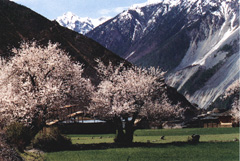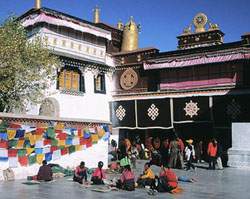Tibet Intriduction
Time:2005-12-06 Author:danfeng | | |
|
 Tibet, the Roof of the World, for centuries the mysterious Buddhist holy place, is locked away in its mountain fastness of Himalaya, and has exercised a unique hold on the imagination of the west. For adventurers and traders it was a land of treasure and riches. Tibet, the Roof of the World, for centuries the mysterious Buddhist holy place, is locked away in its mountain fastness of Himalaya, and has exercised a unique hold on the imagination of the west. For adventurers and traders it was a land of treasure and riches.
Tibet is in the northwest of China. At the turn of the millennium it is changing faster than at any time in TibetĄŻs history. And yet the quintessence of Tibet remains remarkably intact. The temples are still full of pilgrims murmuring mantras in the golden light of yak butter lamps. Butter tea remains the most popular beverage.
Tibet is without doubt one of the most remarkable places to visit in Asia. It offers fabulous monastery sights, breathtaking high-altitude treks, stunning views of the worldĄŻs highest mountains and some of the nicest people you will ever meet.
Area: 1.2 million sq km
Province Capital: Lhasa
Language: Tibetan, Chinese
Nearby Countries: This fortress of a region is located on the southwestern frontier of China, bordering with India, Nepal, Sikkim, Bhutan and Burma to the south, and the Kashmir region to the west. |
|
 Buddhism was introduced into Tibet in the seventh century from India and Central China. After a long and sometimes difficult period of interaction with both versions of Buddhism, Tibetan Buddhism (also known as Lamaism) was formed. It has a strong Tibetan cultural flavor, while keeping the original basic doctrines of Buddhism. Tibetan Buddhism was a kind of theocracy ruled by the Dalai Lama until the 1950s. Tibetan Buddhism is not only a kind of philosophy, but also a spiritual harbor for ordinary Tibetans as well as the inspiration for the creation of countless pieces of religious art. Tibetan Buddhism has a great influence in the daily life of the Tibetan People. There were many different schools of the Tibetan Buddhism in history. The four main existing schools are: the Gelug School (Yellow Sect), the Nyingma School (Red Sect), the Sakya School (Flower Sect) and the Kagyu School (White Sect). Buddhism was introduced into Tibet in the seventh century from India and Central China. After a long and sometimes difficult period of interaction with both versions of Buddhism, Tibetan Buddhism (also known as Lamaism) was formed. It has a strong Tibetan cultural flavor, while keeping the original basic doctrines of Buddhism. Tibetan Buddhism was a kind of theocracy ruled by the Dalai Lama until the 1950s. Tibetan Buddhism is not only a kind of philosophy, but also a spiritual harbor for ordinary Tibetans as well as the inspiration for the creation of countless pieces of religious art. Tibetan Buddhism has a great influence in the daily life of the Tibetan People. There were many different schools of the Tibetan Buddhism in history. The four main existing schools are: the Gelug School (Yellow Sect), the Nyingma School (Red Sect), the Sakya School (Flower Sect) and the Kagyu School (White Sect).
OutsidersĄŻ fascination with Tibet lies not only in the beautiful scenes of snowy mountains, but also with its unique religious and cultural sites. From Lhasa, the capital of the Tibet Autonomous Region, to the pastoral villages spread throughout the the grasslands, there are temples with their golden roofs shinning under the sun. The prayer flags flying in the wind, horns blowing at dawn, and the smoke of incense wafting about are all rich symbols of Tibetan Buddhism. Other important symbols of Tibetan Buddhism are the pilgrims who prostrate themselves every nine steps on their way from their home towns to the holy city of Lhasa. Pilgrims can also be seen throughout Tibet visiting religious sites to erase their sins and accumulate virtue.
In scarcely populated Tibet, areas around major monasteries are usually some of the most densely populated places. For instance, there are tens of thousands of monks living in the three largest temples of Lhasa. Drepung Monastery, for example, is a city in a city. The monasteries are also the places where monks study Buddhism and where religion, art and customs have melted into one whole in Tibet. | | | | | Copyright reserves (C) 2002 [[Athens Silk Road International Travel].
Address:36 Mitropoleos,Athens Greece Post code:10563
TEL:0030-210-3310036, 3310037 ,5203730 Fax: 0030-210-3310069, 5234422
Website: http://www.travelasri.com E-mail: silkroaa@otenet.gr | |
 Tibet, the Roof of the World, for centuries the mysterious Buddhist holy place, is locked away in its mountain fastness of Himalaya, and has exercised a unique hold on the imagination of the west. For adventurers and traders it was a land of treasure and riches.
Tibet, the Roof of the World, for centuries the mysterious Buddhist holy place, is locked away in its mountain fastness of Himalaya, and has exercised a unique hold on the imagination of the west. For adventurers and traders it was a land of treasure and riches.  Buddhism was introduced into Tibet in the seventh century from India and Central China. After a long and sometimes difficult period of interaction with both versions of Buddhism, Tibetan Buddhism (also known as Lamaism) was formed. It has a strong Tibetan cultural flavor, while keeping the original basic doctrines of Buddhism. Tibetan Buddhism was a kind of theocracy ruled by the Dalai Lama until the 1950s. Tibetan Buddhism is not only a kind of philosophy, but also a spiritual harbor for ordinary Tibetans as well as the inspiration for the creation of countless pieces of religious art. Tibetan Buddhism has a great influence in the daily life of the Tibetan People. There were many different schools of the Tibetan Buddhism in history. The four main existing schools are: the Gelug School (Yellow Sect), the Nyingma School (Red Sect), the Sakya School (Flower Sect) and the Kagyu School (White Sect).
Buddhism was introduced into Tibet in the seventh century from India and Central China. After a long and sometimes difficult period of interaction with both versions of Buddhism, Tibetan Buddhism (also known as Lamaism) was formed. It has a strong Tibetan cultural flavor, while keeping the original basic doctrines of Buddhism. Tibetan Buddhism was a kind of theocracy ruled by the Dalai Lama until the 1950s. Tibetan Buddhism is not only a kind of philosophy, but also a spiritual harbor for ordinary Tibetans as well as the inspiration for the creation of countless pieces of religious art. Tibetan Buddhism has a great influence in the daily life of the Tibetan People. There were many different schools of the Tibetan Buddhism in history. The four main existing schools are: the Gelug School (Yellow Sect), the Nyingma School (Red Sect), the Sakya School (Flower Sect) and the Kagyu School (White Sect).